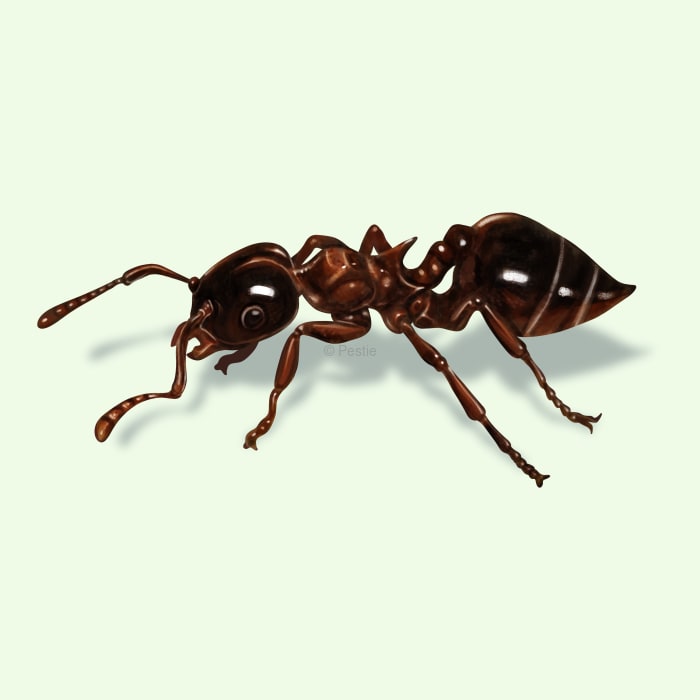How to identify and get rid of acrobat ants

When the ant circus invades your home
You would think that with a name like acrobat ants, they would be better at performing impressive tricks. Their greatest act? Lifting their abdomen over their head. That probably counts as some sort of handstand, right?
While they may not be swinging from a trapeze, acrobat ants can find their way inside homes and make nests inside walls. However, acrobat ants are usually a sign that you have moisture in your walls or rotten structural elements within your home. These ants prefer to nest in trees or decaying wood, but they can always set up camp in your yard.
Acrobat ants don't excavate into trees or fallen logs. Instead, they take advantage of galleries left behind by other wood-boring insects and move their nests in. The colonies typically have one egg-laying queen, but satellite nests cooperating with the main nest may be nearby.
Finding ant nests in your yard can be frustrating, but acrobat ants are more of a nuisance than a serious pest. They don't often raid your kitchen or nest inside, but they can become an issue if certain conditions are right.
How to identify acrobat ants
Identifying acrobat ants involves looking for their unique heart-shaped abdomen when viewed from above and their ability to lift their abdomen over their thorax when disturbed or threatened. These ants are usually light brown to black and are pretty small. Look for small ant paths leading to and from your home, especially around wiring or plumbing entrances.
How big are acrobat ants?
Acrobat ants can grow up to about 1/16 to 1/6 inches long, depending on the species. So, while they're not the biggest ants you'll meet, they're definitely noticeable.
What other ants look like acrobat ants?
There are several species of acrobat ants, and it can be difficult to identify them without professional help. However, you can tell acrobat ants from other species of ants that look similar to them:
- Odorous house ants
- Carpenter ants
- Argentine ants
- Little black ants
Look for the heart-shaped abdomen on acrobat ants for a tell-tale sign.
Where do acrobat ants live?
Acrobat ants can be found throughout the US, both in rural and urban environments. Check out areas with moisture issues like windows, foam panels, or damaged wood in your home. Outside, they love making their homes in rotting wood, under rocks, or inside tree stumps. If it's cozy and damp, acrobat ants might call it home.
How to get rid of acrobat ants
Keeping acrobat ants away is similar to keeping most ants out of your pantry, but with acrobat ants, there's something else you need to keep in mind. Acrobat ants love moisture, especially damp wood.
So, if you suspect you have acrobat ants in your walls or floors, then there's a good chance you have a leak somewhere, too!
Follow these tips to prevent acrobat ants from marching inside your home:
- Remove moisture sources: Fix leaks and ensure good ventilation in crawl spaces and attics.
- Seal entry points: Caulk cracks and crevices around your home's exterior.
- Trim tree branches and shrubs away from your house: This prevents easy access. Acrobat ants have even been known to crawl on power lines into homes. A tightrope act, indeed!
- Keep firewood and building materials away from your home's foundation: These can be perfect nesting sites for ants.
Another great way to prevent ants from coming inside your home or even making nests in your yard is with an insect barrier spray. Pestie offers a DIY solution that takes no time to apply inside and around your home for effective insect control all year.
Treat acrobat ants with Pestie
If you're still having trouble keeping acrobat ants away, the best option is to use a pro-grade, effective pest control solution like Pestie.
Pestie is a do-it-yourself pest control solution that's specially designed to keep acrobat ants and other pests away from your home.
With Pestie, you can rest easy knowing that your living space is protected and free of creepy crawlies. And the best part? It's designed for people, pets, and the planet, so you can say goodbye to harsh chemicals and hello to peace of mind!
- Save hundreds compared to traditional annual pest plans
- People, pet, and planet-friendly
- Pro-grade customized formulas
Quick facts
- Scientific name
Genus - Crematogaster
- Colors
Reddish brown and black
- Life span
10+ years
- Diet
Sweets, aphid honeydew, small insects, wasp brood
How dangerous are Acrobat Ants?
Low danger risk
Acrobat ants seldom bite and don't sting. However, they can strip the insulation off wiring, increasing the risk of power shortages, outages, and even fires.
Acrobat ants emit venom from their abdomen that can repel or sometimes kill other ant species.








